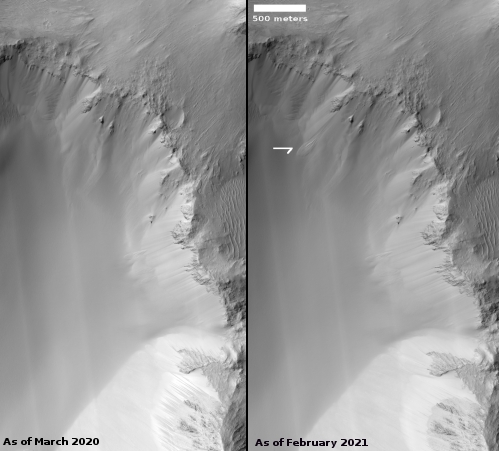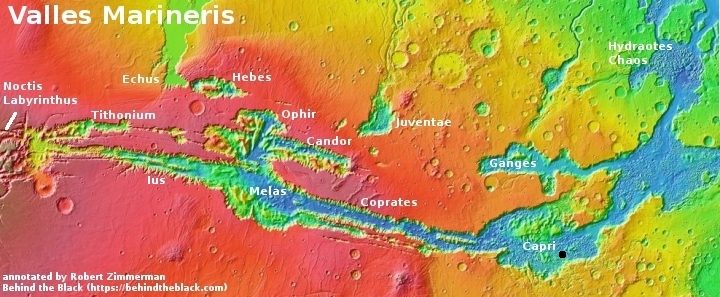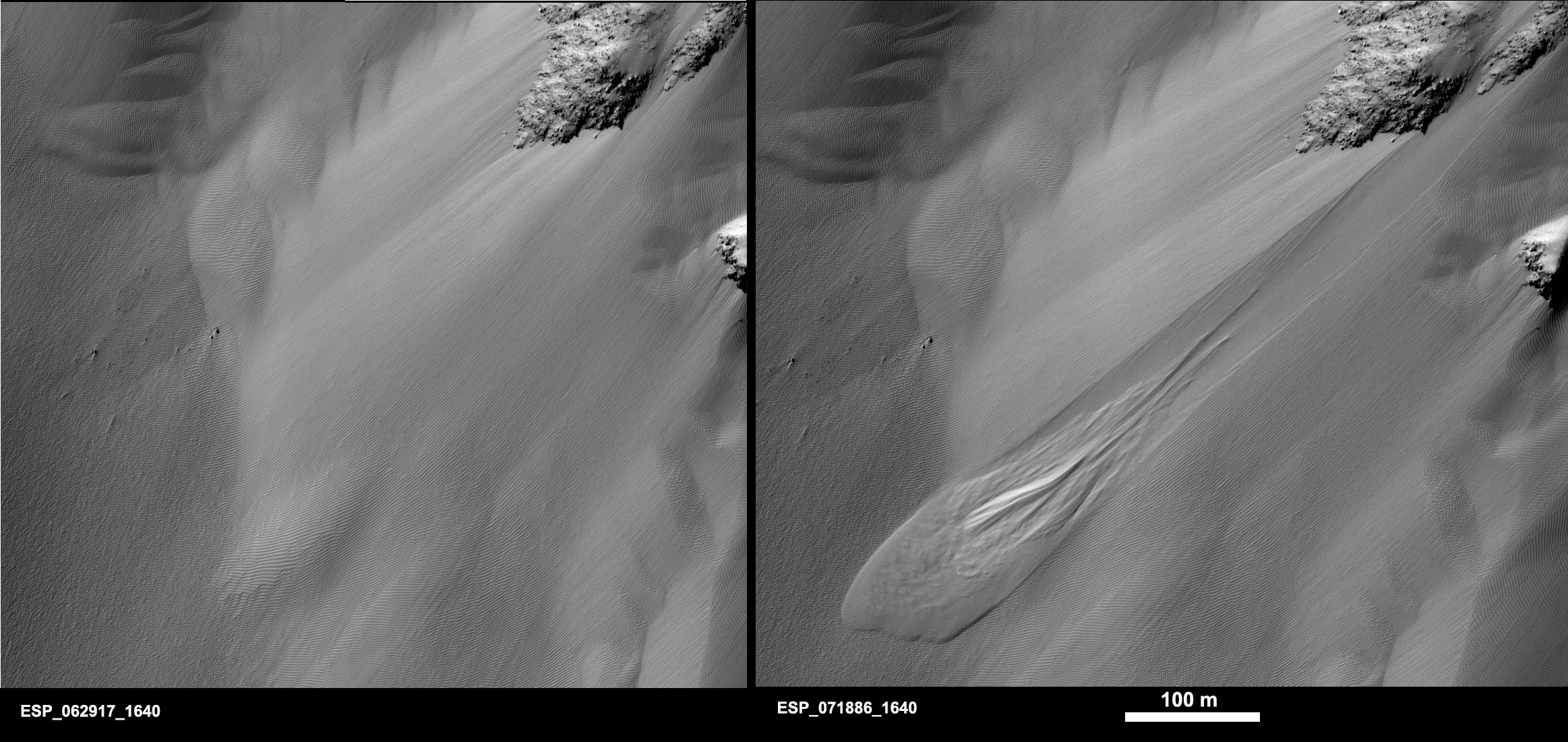Recent avalanche on Mars

For full images go here and here.
Cool image time! Today the science team for the high resolution camera on Mars Reconnaissance Orbiter (MRO) released images showing a very recent avalanche, or slumping, on the interior slopes of what looks like a small three-mile-wide crater inside the easternmost reaches of the giant canyon Valles Marineris.
The comparison above, reduced and rotated to post here, is their close-up showing the change, which occurred sometime between March 2021 and February 2022. The wider comparison on the right, cropped, reduced, and annotated by me, shows a wider view to help place this slumping in the context of the crater.
Calling this an avalanche is not really accurate, as it isn’t really the fall of boulders and rocks, but the quick slumping downward of an entire section of what looks like dust or sand. As Alfred McEwen of the Lunar & Planetary Laboratory in Arizona writes in the caption:
In geology, a slump forms a mass of loosely consolidated material or a rock layer moves a short distance down a slope. The movement is characterized by sliding along a concave-upward or planar surface.
…Causes of slumping on Earth include earthquake shocks, reduction of friction through wetting, freezing and thawing, undercutting (such as from a stream), and loading of a slope. Based on the geomorphology of this region and other active slumps seen on Mars, we suspect loading of the slope via smaller-scale activity like gullies, recurring slope lineae and windblown deposits may have contributed to the slumping. Perhaps a Marsquake triggered the movement.
McEwen estimates the length of the slump to be just under a half mile long. That this is located in Mars’ dry equatorial regions is probably why he favors a quake as a cause rather than a freeze-thaw cycle of ice, though the latter is not impossible based on the presently available data.
The wider comparison also shows other changes in several streaks in the lower right. These might be slope streaks or recurring slope lineae, which while superficially similar are fundamentally different.
The black dot near the label Capri on the eastern end of Valles Marineris in the overview map below marks the location of this crater. The floor of the canyon in this region is actually very complex chaos terrain, with many mesas and hills packed randomly together, with this crater apparently a later impact on top of this hilly terrain.

On Christmas Eve 1968 three Americans became the first humans to visit another world. What they did to celebrate was unexpected and profound, and will be remembered throughout all human history. Genesis: the Story of Apollo 8, Robert Zimmerman's classic history of humanity's first journey to another world, tells that story, and it is now available as both an ebook and an audiobook, both with a foreword by Valerie Anders and a new introduction by Robert Zimmerman.
The print edition can be purchased at Amazon or from any other book seller. If you want an autographed copy the price is $60 for the hardback and $45 for the paperback, plus $8 shipping for each. Go here for purchasing details. The ebook is available everywhere for $5.99 (before discount) at amazon, or direct from my ebook publisher, ebookit. If you buy it from ebookit you don't support the big tech companies and the author gets a bigger cut much sooner.
The audiobook is also available at all these vendors, and is also free with a 30-day trial membership to Audible.
"Not simply about one mission, [Genesis] is also the history of America's quest for the moon... Zimmerman has done a masterful job of tying disparate events together into a solid account of one of America's greatest human triumphs."--San Antonio Express-News

For full images go here and here.
Cool image time! Today the science team for the high resolution camera on Mars Reconnaissance Orbiter (MRO) released images showing a very recent avalanche, or slumping, on the interior slopes of what looks like a small three-mile-wide crater inside the easternmost reaches of the giant canyon Valles Marineris.
The comparison above, reduced and rotated to post here, is their close-up showing the change, which occurred sometime between March 2021 and February 2022. The wider comparison on the right, cropped, reduced, and annotated by me, shows a wider view to help place this slumping in the context of the crater.
Calling this an avalanche is not really accurate, as it isn’t really the fall of boulders and rocks, but the quick slumping downward of an entire section of what looks like dust or sand. As Alfred McEwen of the Lunar & Planetary Laboratory in Arizona writes in the caption:
In geology, a slump forms a mass of loosely consolidated material or a rock layer moves a short distance down a slope. The movement is characterized by sliding along a concave-upward or planar surface.
…Causes of slumping on Earth include earthquake shocks, reduction of friction through wetting, freezing and thawing, undercutting (such as from a stream), and loading of a slope. Based on the geomorphology of this region and other active slumps seen on Mars, we suspect loading of the slope via smaller-scale activity like gullies, recurring slope lineae and windblown deposits may have contributed to the slumping. Perhaps a Marsquake triggered the movement.
McEwen estimates the length of the slump to be just under a half mile long. That this is located in Mars’ dry equatorial regions is probably why he favors a quake as a cause rather than a freeze-thaw cycle of ice, though the latter is not impossible based on the presently available data.
The wider comparison also shows other changes in several streaks in the lower right. These might be slope streaks or recurring slope lineae, which while superficially similar are fundamentally different.
The black dot near the label Capri on the eastern end of Valles Marineris in the overview map below marks the location of this crater. The floor of the canyon in this region is actually very complex chaos terrain, with many mesas and hills packed randomly together, with this crater apparently a later impact on top of this hilly terrain.

On Christmas Eve 1968 three Americans became the first humans to visit another world. What they did to celebrate was unexpected and profound, and will be remembered throughout all human history. Genesis: the Story of Apollo 8, Robert Zimmerman's classic history of humanity's first journey to another world, tells that story, and it is now available as both an ebook and an audiobook, both with a foreword by Valerie Anders and a new introduction by Robert Zimmerman.
The print edition can be purchased at Amazon or from any other book seller. If you want an autographed copy the price is $60 for the hardback and $45 for the paperback, plus $8 shipping for each. Go here for purchasing details. The ebook is available everywhere for $5.99 (before discount) at amazon, or direct from my ebook publisher, ebookit. If you buy it from ebookit you don't support the big tech companies and the author gets a bigger cut much sooner.
The audiobook is also available at all these vendors, and is also free with a 30-day trial membership to Audible.
"Not simply about one mission, [Genesis] is also the history of America's quest for the moon... Zimmerman has done a masterful job of tying disparate events together into a solid account of one of America's greatest human triumphs."--San Antonio Express-News



Based on looking at the headscarp area, and the lateral boundaries of the slump, it appears to be very shallow, affecting only the immediate surface of the soil. I doubt it pulled more than a couple feet of material at most off the slope. Some lower boundary prevented deeper soil from moving. So the question is – what is the profile of Martian soil in this area?